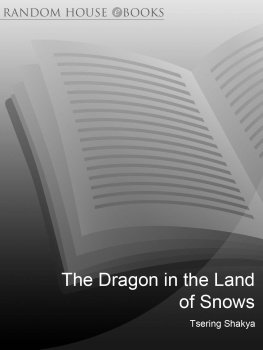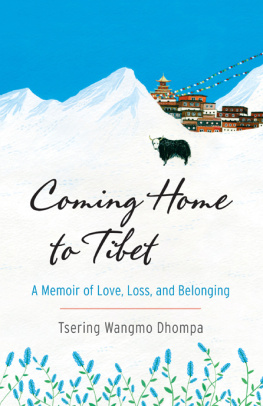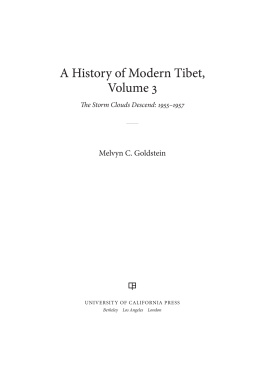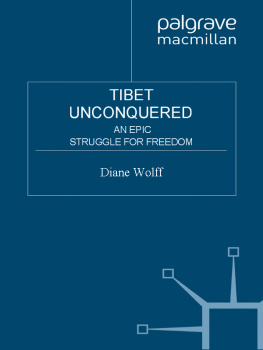CONTENTS
About the Author
Tsering Shakya was born in Tibet in 1959. In 1967, with the onslaught of the Cultural Revolution, his family fled to India. Following secondary education in England he went to the School of Oriental and African Studies at London University and in 1982 graduated with BA Hons in History and Social Anthropology.
Over the last ten years Tsering Shakya has regularly briefed politicians on Tibet at the Foreign Office and the European Parliament. He has written numerous articles, taken part in television and radio discussions, and is frequently consulted on Tibetan matters by the BBC, The Times, the Observer and the Guardian. In addition to his work as a journalist, broadcaster, researcher and adviser he is the translator of Fire Under the Snow: The Testimony of a Tibetan Prisoner (1997).
In recognition of his work in 1997 Tsering Shakya was awarded a four-year Research Fellowship in Tibetan Studies at the School of Oriental and African Studies.
This is an exceptional study on the political history of modern Tibet in that it draws on rare historical documents that had remained inaccessible to earlier authors. Samten Karmay, Directeur de Recherche, CRNS, Paris; President, International Association for Tibetan Studies
Tibet under Communist domination has rightly attracted considerable scholarly attention. But none has so far excelled in its comprehensiveness and even-handed approach to current history based on almost all the existing sources of information, as this book does. Dawa Norbu, Professor of International Studies, Jawaharlal Nehru University
This account of the history of Tibet is distinguished not only by its Tibetan authorship, but also by its meticulous research, careful objectivity and lack of rancour. As one would expect, it describes Chinas suppression of Tibetan political freedoms and the destruction and marginalisation of Tibetan culture in detail, but it also seeks to understand the Chinese perspective. The book therefore provides us not only with a detailed analysis of the way in which Tibets many tragedies have unfolded, but also with insights and perspectives that might ultimately contribute to some easing of its woes. Dr Michael Hutt, Head of Department of South Asia, School of Oriental and African Studies, London
The Dragon in the Land of Snows
A History of Modern Tibet Since 1947
Tsering Shakya

ONE
The Lull Before the Storm
ON 15 AUGUST 1947, India became an independent nation and inherited the political influence and the privileges that Britain had gained in Tibet. This historic transition was marked in Lhasa with a simple ceremony: the Union Jack was lowered and the Indian national flag was raised in its place. Hugh Richardson, the last British representative in Lhasa, became the first Indian representative. Later he wrote: the transition was almost imperceptible. The existing staff was retained in its entirety and the only obvious change was the change of flag. But this was deceptive. The emergence of the new Republic of India changed the traditional balance of power, and Asian nationalists envisaged that the collapse of the British Empire would lead to the birth of a new order in Asia. And thus the history of modern Tibet in the second half of the twentieth century was to become a search for the maintenance of its independence and international stature in this emerging regional order.
Tibet occupied 1.2 million square kilometres of land sandwiched between the two giants of Asia. To the south, the mighty Himalayas formed a natural boundary with India. To the north and the east was China. For centuries Tibet had absorbed cultural influences from both these countries. The politics of both countries had exercised considerable influence over the historical development of Tibet. This enormous landmass had always been of strategic importance to the great powers. China had always coveted Tibet as the treasure house of the western region. When the British ruled India, they had always regarded Tibet as crucial to the security of India and their imperial ambitions. As a result, they sought to gain influence in Tibet such as no other Western country had ever enjoyed before. From 1913 onwards Britain achieved considerable prestige in the country, thereby bringing it within the British sphere of influence. Tibet, for her part, wanted to cultivate good relations with Britain. It was the price for keeping the Chinese at bay: as British influence increased across the Himalayas, so Chinese prestige and influence faded.
The end of the Second World War saw the collapse of the old imperial powers in Asia. The British were forced out of the Indian sub-continent and their imperial ambitions reached a convenient end. The Japanese had been defeated and expelled from the Asian mainland, which led to the eventual victory of the Communists in China. It was a shift in the balance of power that marked the beginnings of the demise of Tibet as an independent state.
When the Republic of China was founded, its authority in Tibet was virtually non-existent. One of the primary objectives of the Guomindang was to restore its influence and a number of missions were dispatched to Lhasa to re-establish relations with the Tibetans. The loss of Chinese influence was seen by the emerging Chinese nationalists as proof of Western imperialist attempts to undermine the Chinese nation. After the collapse of the Qing Dynasty in 1911, China was internally divided and militarily weak. The Chinese nationalists therefore could not put into practice their claim that China was a nation based on the unity of five races. Tibet remained outside the control of the Guomindang government. Moreover, Tibetans were convinced that they should have their rightful place in the world as an independent nation and were thus determined to oppose Chinese attempts to gain a foothold in Lhasa. However, we shall see later that the Guomindang regime was determined to assert its claims over Tibet.
Tibet and its Neighbours
To a large extent Tibets ability to survive as an independent nation depended on its southern neighbour, British India. Indias willingness to preserve Tibet as a natural buffer state between China and itself was crucial to the future status of Tibet. The question was: would the newly independent India have the will and the power to safeguard Tibets inherited privileges or would these be discarded as an anachronism of the age of imperialism? At first, India appeared willing to maintain the privileges secured by its former ruler. But the question remained: would India be able to resist pressure from the newly emerging China? The new India lacked the economic and military power possessed by her former colonial ruler, whose empire had represented one of the greatest powers in the world, with naval and military power stretched across the globe. The primary tasks facing the Indian leaders were economic development of the country and cessation of the sectarian strife, which had already cost thousands of lives. Relations with the new Islamic state of Pakistan were also on the brink of collapse. Therefore, the problems that were about to unfold in the northern borders along the Himalayan range were the least of their concerns.
However, the new leaders of India should have been aware of the delicate situation they were about to inherit from the British. In March 1947, the Indian Council for World Affairs, with support from the Congress leaders, convened an Inter-Asian Relations Conference; Nehru hailed it as a landmark in the history of Asia, intended to discuss the role of Asia in the post-war and post-colonial period. Initially Tibet was represented as an independent nation. A map displayed at the conference showed Tibet as separate from China and the Tibetan delegation unveiled for the first time the newly invented national flag. These symbols of Tibets new-found international status were rejected by the Chinese delegation, which protested to the Indian organisers.
Next page






